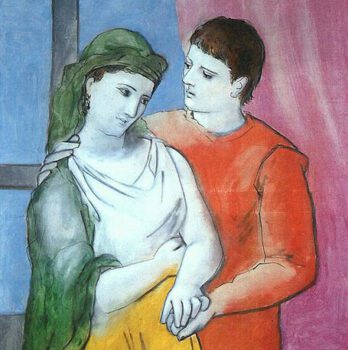The Lovers by Pablo Picasso: A Story Behind the Brushstrokes
In the quiet corners of art history, there are pieces that whisper more than they shout, paintings that invite us into private, tender moments caught in pigment and brush. Among such works is Pablo Picasso’s evocative painting The Lovers (Les Amants), a piece that captures an intimate, almost cinematic closeness between two figures. The painting is a testament not only to Picasso’s evolving mastery of form and emotion but also to the mysteries and revelations of love, passion, and connection.
But what is happening in The Lovers? Who are these entranced figures? Is it a scene imagined, remembered, or real? And why does this quiet, romantic painting still command such fascination nearly a century after its creation?
Let’s journey through the canvas, its colors, its context, its characters, and uncover the layered story behind Picasso’s The Lovers.
A Glance at the Canvas: What is Happening in The Lovers?
At first glance, The Lovers is deceptively simple. A man and a woman lean toward each other, foreheads nearly touching, caught in a suspended moment of closeness. Their gazes are locked, soft and reverent, the space between them charged with unspoken affection. The palette is muted and serene, dominated by earth tones and soft pastels, far from the violent contortions of Picasso’s Cubist works or the stark brutality of Guernica.
Here, Picasso steps away from abstraction and brutality, allowing tenderness to take the stage. The figures are rendered with a subtlety and naturalism more typical of his Neoclassical period in the early 1920s. Their poses speak volumes, eyes drawn inward, bodies gravitating toward one another. There’s no overt sexuality, yet the emotional intimacy is unmistakable. It’s the moment before a kiss, before words are spoken, when everything is felt but nothing is said.
The Lovers captures the fragile, magical stillness of emotional connection, the type of closeness that makes the world seem to hush around two people.
The Meaning of The Lovers Painting by Picasso
To understand the meaning of The Lovers, we must also understand the man behind the brush.
Pablo Picasso (1881–1973) was an artistic chameleon, restlessly moving through styles, periods, and mediums. From the melancholic Blue Period to the fragmented Cubist masterpieces, Picasso was never static. Yet in the early 1920s, following the chaos of World War I, Picasso entered a more classical phase, a return to harmony, order, and the human figure.
The Lovers, painted in 1923, falls squarely into this Neoclassical period. At this time, Picasso’s art turned toward calm, romantic themes. His brushstrokes softened. His figures grew in size and presence. In The Lovers, we see not just two people, but two ideals: masculine strength and feminine grace, opposites held together in emotional symmetry.
The painting’s meaning, then, revolves around unity. It’s a study in emotional harmony, in the sacredness of connection. Some have even likened it to a modern-day Pietà, not in terms of sorrow, but in the purity and gravity of touch. It is love as reverence, devotion, stillness.
At a time when Europe was rebuilding from devastation, The Lovers offered a glimpse of human hope, connection amidst a fractured world.
Who Were Picasso’s Lovers?
The identity of the couple in The Lovers has intrigued art historians for decades. While Picasso often used real people, especially romantic partners, as subjects in his paintings, he also blurred lines between reality and imagination. In this case, there is good reason to believe that the painting draws heavily from Picasso’s relationship with one particular woman: Olga Khokhlova.
Olga was a Russian-Ukrainian ballerina with the Ballets Russes, whom Picasso met in 1917 while designing sets for the ballet Parade. She would go on to become his first wife in 1918. By the early 1920s, Olga was not only his muse but also a stabilizing presence in his otherwise chaotic personal life. She brought discipline and decorum to Picasso’s world, dinners at set hours, formal attire, bourgeois respectability.
This painting likely depicts Picasso and Olga, not necessarily as a strict portrait, but as symbolic figures. The woman’s refined features and graceful posture align with Olga’s aristocratic bearing. The man, with his broad shoulders and introspective gaze, may be Picasso himself, rendered with idealized restraint.
There’s tenderness in the way the man leans toward the woman, his eyes soft, searching. It is perhaps a self-portrait not of appearance but of emotion, a visual diary entry from a moment when love was quiet and unthreatened.
But the beauty of The Lovers lies in its universality. Whether or not the figures are Picasso and Olga, they speak for every couple who has ever shared a private moment of closeness. Their love is ours.
Is The Lovers a True Story?
In a sense, yes, and no.
Like much of Picasso’s art, The Lovers straddles the boundary between autobiography and invention. There’s no evidence of a specific moment or event that inspired the painting. Yet emotionally, it captures a real phase in Picasso’s life: the brief period of peace and domesticity he shared with Olga in the early 1920s.
It’s a “true story” in the way a poem can be true, emotionally authentic, even if not factually literal. The figures are imbued with real feeling, but they are also elevated to archetypes: lovers as eternal ideals.
Moreover, The Lovers is true to Picasso’s artistic journey. In this painting, we see him reaching for classical ideals, reimagining ancient Greco-Roman frescoes and Renaissance poise through a modern lens. It is Picasso dreaming, not just of personal love, but of a world where beauty and harmony might still be possible.
The Painting’s Place in Picasso’s Career
The Lovers marks an important phase in Picasso’s evolving style. The 1920s were a period of contradiction for him: on one hand, he was experimenting with Surrealism; on the other, he was producing serene, naturalistic works like this one. The painting doesn’t shock or disturb. Instead, it soothes.
It’s also one of the clearest examples of his brief return to Neoclassicism, where he embraced more traditional forms and techniques. After years of Cubist dissection, breaking faces and forms into geometric shards, Picasso here chooses to construct rather than deconstruct. He shows that he can be just as powerful with a gentle hand as with a radical one.
In the grand arc of his work, The Lovers is a rare quiet moment. It’s the pause before another stylistic storm.
Where is Picasso’s The Lovers Today?
As of today, The Lovers (1923) is part of the permanent collection at the Musée Picasso in Paris, France. The museum, located in the historic Hôtel Salé in the Marais district, houses one of the most extensive collections of Picasso’s works in the world, including paintings, sculptures, drawings, ceramics, and personal archives.
Visitors to the Musée Picasso can stand before The Lovers and feel its serene pull firsthand. It remains one of the museum’s most emotionally resonant pieces, not as famous as Guernica or Les Demoiselles d’Avignon, but unforgettable in its tenderness.
The painting is often displayed in a room devoted to Picasso’s Neoclassical period, offering a moment of reflection amidst the artist’s otherwise chaotic and revolutionary output.
Why The Lovers Still Matters
In a time when images flash past our eyes in seconds, The Lovers asks us to slow down. It demands presence. It invites us to feel something soft and sacred, something that can’t be tweeted or commodified.
This painting matters because it reveals another side of Picasso. Not the angry political artist. Not the ego-driven innovator. But the man who knew what it meant to be moved by someone’s presence.
It also matters because it gives love its due. Not in a Hallmark, sugary sense, but in the raw, reverent way that love really feels when it’s deep and mutual and quietly understood.
In a world that often prizes passion’s flames, The Lovers reminds us of its embers, those lasting, glowing moments of connection that don’t burn but warm.
The Lovers by Pablo Picasso is more than a painting. It is a moment of stillness in a life and an art career marked by constant change. It speaks not just of romantic love but of emotional attunement, the kind that doesn’t need words or explanation.
Whether it is Picasso and Olga, or two anonymous figures from the artist’s imagination, what matters is the truth it conveys: that love, when real, is quiet, powerful, and eternal.
And like all great works of art, The Lovers does what language often fails to do. It captures the sacred pause between two heartbeats. The electricity of nearness. The silence that says everything.
As long as people fall in love, and long for love, The Lovers will speak to us. Through oil and canvas, through time and space, Picasso whispers what it means to feel deeply. To be human. To love.




